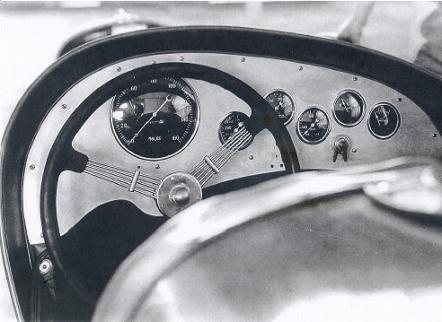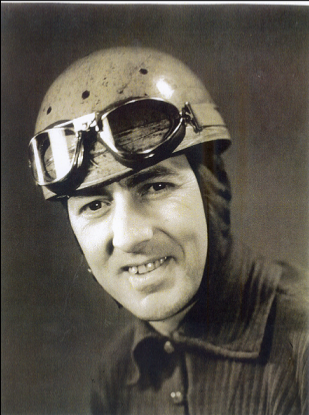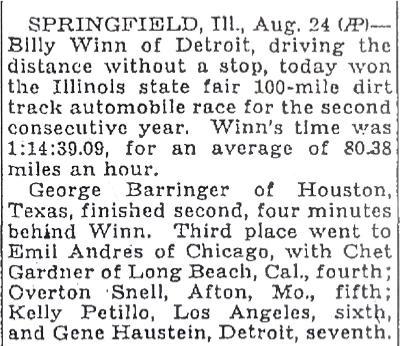Barringer Was an Icon of Early American Championship Auto Racing
Indianapolis 500 Years: 1934-1946


. Harry A. Miller, whose special motors have won every race here since 1928, entered a team of 10 racing cars today for the 1935 speedway event. He designated the cars as "Ford V-8 Specials."
All are front-wheel driven, with a chassis designed and built by Miller in his Detroit plant. They constitute the largest team ever to enter the race.
Miller names six drivers for the cars, including Peter De Paolo, Dave Evans, Cliff Bergere, Billy Winn, George Barringer, and Ted Horn.
From the very beginning, time was the major factor.
The inevitable happened.
The cars were rushed together in an environment of work that went on twenty-four hours a day and seven days a week. Only four cars qualified for the race and all retired early for the same reason, a seized bearing in the steeringbox, overheated by its proximity to the exhaust.
George Barringer tested the very first car.
The first Ford was among 34 cars lined up at the speedway on May 14, 1935. The next day DePaolo, Bergere and Barringer took turns driving the car and the top lap speed was 107 mph.
On Friday May 17, Rex Mays turned the fastest practice lap. The good news that day was that another blue Ford Special arrived at Indy for driver Dave Evans, but the bad news was that Bergere quit.
He decided the cars didn't have enough power or speed to win the race. On May 18, nine of 12 cars making qualifying runs made the field for the race, but the two Fords weren't among them. That same day, mechanic Jimmy Jackson hauled a third Ford in from Detroit. DePaolo also quit the Ford team, saying the cars weren't safe.
On Sunday May 19, a fourth Ford arrived. Winn practiced in it and hit 106 mph, but days passed and though a fifth Ford racer arrived, with a week to go, not one of the Ford Specials had attempted to qualify.
By May 24 there were eight Miller-Fords at the speedway and everyone was talking about the new cars. Three days before the race, none of the Miller-Fords had made qualification runs. Then, Ted Horn and his riding mechanic Bo Huckman qualified their black-and-white Miller-Ford at 113 mph. By the end of that day, a Ford driven by newly hired Johnny Seymour qualified.
This left six positions in the race open for the Miller-Fords to shoot at. Another of the replacement drivers, George Bailey, qualified at 113.432 mph. Then it rained and slowed things down. Billy Winn failed to qualify the white car and managed only 97.5 mph.
George Barringer completed five laps in the red and cream car but only made 105 mph, not good enough.
By this time the deadline was getting close and Bob Sall and riding mechanic Doc MacKenzie pushed the gold Ford to 110.5 mph, which was fast enough to bump Emil Andres from the race.
Dave Evans went next but his blue Ford managed only 109.9 mph. Ford drivers Wes Crawford and L.L. Corum did not attempt to qualify and the 10th Ford was not ready. It was the very first time that all cars qualified to race the Indy 500, had done so at over 110 mph.
The 500-mile race was held on May 30. Bailey's car, the fastest of the four Ford qualifiers, was still getting repairs because it would not go into gear. He and riding mechanic Arthur Chevrolet could not be pushed to the starting line. Ted Horn's black-and-white No. 43 was staged in the center position in the ninth row next to Seymour's No. 42 car. There was an empty spot for Bailey's car in the middle of the 10th row. Sall's gold No. 46 was in the last row.
By lap 10, Horn's car was in 23rd position. Seymour was 25th, Sall was 28th and Bailey was 30th. Before the 125th mile, Sall dropped out with steering problems. Horn was in 20th . Ten laps later, a driver change put George Barringer in Seymour's car with Jimmy Jackson riding shotgun. Bailey came in for a long, almost five-minute pit stop and then, a few minutes later, he dropped out with a frozen steering system. A few minutes later Barringer was out, also with steering issues. Horn lasted until the 145th lap. By then he could no longer steer his car.
It was later determined that the aluminum steering boxes used in the car were positioned too close to the exhaust manifold to last for 500 miles. The heat of the exhaust gases caused the bronze gears inside to expand and eventually seize up


George Barringer at Indy in 1935. This was one of the beautiful red and white, Miller Fords
Dashboard of the 1935 Miller Fords.
Barringer Finishes Second at Springfield
In 1935, a mechanic still rode with drivers in some AAA races. On September 9, 1935, Barringer and his mechanic, Ollie Wilkinson of Ann Harbor, Michigan were involved in a single-car wreck.
It occurred at the Altoona-Tyrone Speedway in Tipton, Pennsylvania.
According to the newspaper:
Barringer Uninjured,
Mechanic Slightly Hurt as
Car Somersaults at Tipton.
Only one accident in which the driver and his riding mechanic narrowly escaped serious injury when their car turned a complete forward somersault after a tire blew out during Saturday's 100-mile Speed Classic.
George Barringer, youthful Indianapolis driver was bringing his mount around the southeast curve at a fast clip on the 89th lap, when the right front tire blew out, cracking like a shot from a rifle.
The blowout, according to Barringer, threw his machine out of control and into the inside guard rail. Striking the rail, the rear of the car flew up, making a complete turn in the air. The car landed on its wheels on the other side of the fence.
Neither Barringer nor his riding mechanic was thrown out until the car landed. The impact on the wheels jolted them out.
Barringer escaped unhurt, but Wilkinson was treated at the field hospital fro abrasions and cuts.
While Barringer had several wrecks, none were serious enough to sideline him for any length of time.




. Harry A. Miller, whose special motors have won every race here since 1928, entered a team of 10 racing cars today for the 1935 speedway event. He designated the cars as "Miller-Fords."
All are front-wheel driven, with a chassis designed and built by Miller in his Detroit plant. They constitute the largest team ever to enter the race.
Miller names six drivers for the cars, including Peter De Paolo, Dave Evans, Cliff Bergere, Billy Winn, George Barringer, and Ted Horn.
From the very beginning, time was the major factor.
The inevitable happened.
The cars were rushed together in an environment of work that went on twenty-four hours a day and seven days a week. Only four cars qualified for the race and all retired early for the same reason, a seized bearing in the steeringbox, overheated by its proximity to the exhaust.
George Barringer tested the very first car.
The first Ford was among 34 cars lined up at the speedway on May 14, 1935. The next day DePaolo, Bergere and Barringer took turns driving the car and the top lap speed was 107 mph.
On Friday May 17, Rex Mays turned the fastest practice lap. The good news that day was that another blue Ford Special arrived at Indy for driver Dave Evans, but the bad news was that Bergere quit.
He decided the cars didn't have enough power or speed to win the race. On May 18, nine of 12 cars making qualifying runs made the field for the race, but the two Fords weren't among them. That same day, mechanic Jimmy Jackson hauled a third Ford in from Detroit. DePaolo also quit the Ford team, saying the cars weren't safe.
On Sunday May 19, a fourth Ford arrived. Winn practiced in it and hit 106 mph, but days passed and though a fifth Ford racer arrived, with a week to go, not one of the Ford Specials had attempted to qualify.
By May 24 there were eight Miller-Fords at the speedway and everyone was talking about the new cars. Three days before the race, none of the Miller-Fords had made qualification runs. Then, Ted Horn and his riding mechanic Bo Huckman qualified their black-and-white Miller-Ford at 113 mph. By the end of that day, a Ford driven by newly hired Johnny Seymour qualified.
This left six positions in the race open for the Miller-Fords to shoot at. Another of the replacement drivers, George Bailey, qualified at 113.432 mph. Then it rained and slowed things down. Billy Winn failed to qualify the white car and managed only 97.5 mph.
George Barringer completed five laps in the red and cream car but only made 105 mph, not good enough.
By this time the deadline was getting close and Bob Sall and riding mechanic Doc MacKenzie pushed the gold Ford to 110.5 mph, which was fast enough to bump Emil Andres from the race.
Dave Evans went next but his blue Ford managed only 109.9 mph. Ford drivers Wes Crawford and L.L. Corum did not attempt to qualify and the 10th Ford was not ready. It was the very first time that all cars qualified to race the Indy 500, had done so at over 110 mph.
The 500-mile race was held on May 30. Bailey's car, the fastest of the four Ford qualifiers, was still getting repairs because it would not go into gear. He and riding mechanic Arthur Chevrolet could not be pushed to the starting line. Ted Horn's black-and-white No. 43 was staged in the center position in the ninth row next to Seymour's No. 42 car. There was an empty spot for Bailey's car in the middle of the 10th row. Sall's gold No. 46 was in the next to last row.
By lap 10, Horn's car was in 23rd position. Seymour was 25th, Sall was 28th and Bailey was 30th. Before the 125th mile, Sall dropped out with steering problems. Horn was in 20th . Ten laps later, a driver change put George Barringer in Seymour's car with Jimmy Jackson riding shotgun. Bailey came in for a long, almost five-minute pit stop and then, a few minutes later, he dropped out with a frozen steering system. A few minutes later Barringer was out, also with steering issues. Horn lasted until the 145th lap. By then he could no longer steer his car.
It was later determined that the aluminum steering boxes used in the car were positioned too close to the exhaust manifold to last for 500 miles. The heat of the exhaust gases caused the bronze gears inside to expand and eventually seize up. The cars ran a little bit better in later 500s, when Miller engines were installed to eliminate the steering box heat ups. Herb Ardinger drove one of the cars to a sixth place finish in 1936 and Cliff Bergere took another to third in 1939.












